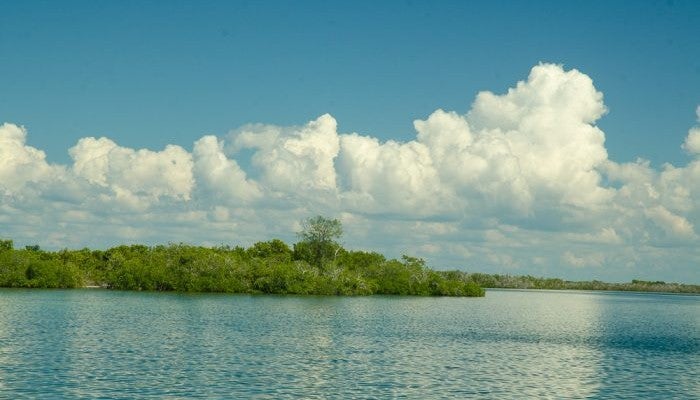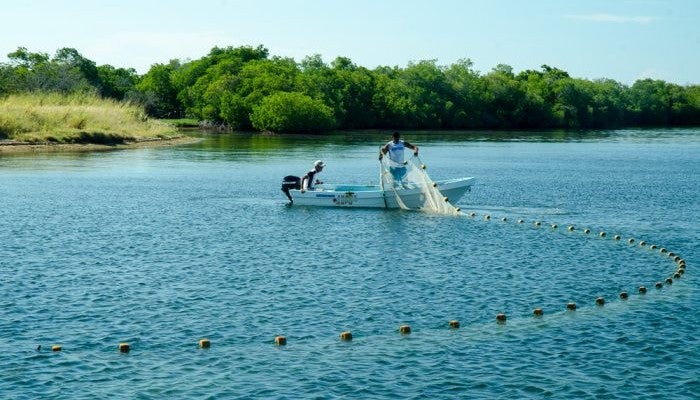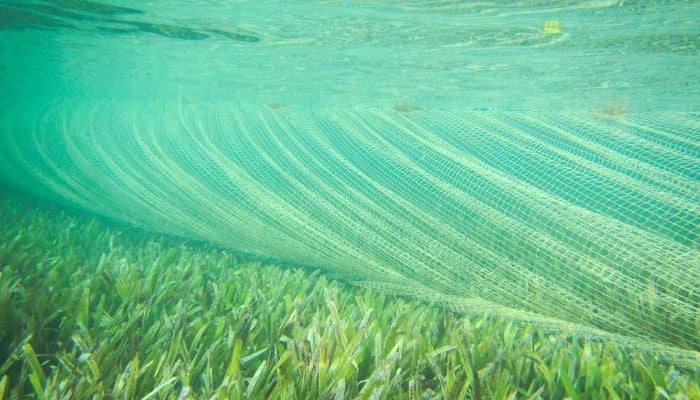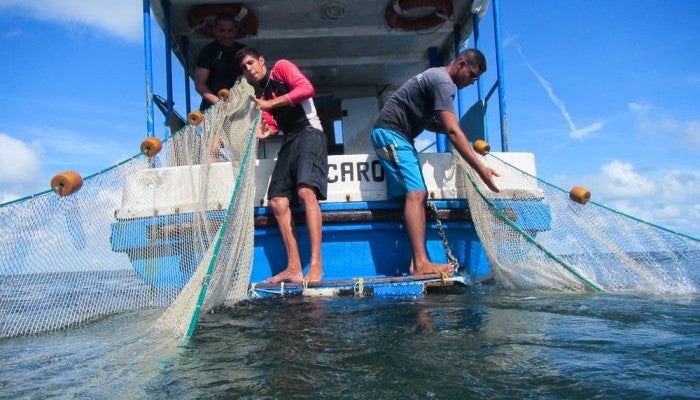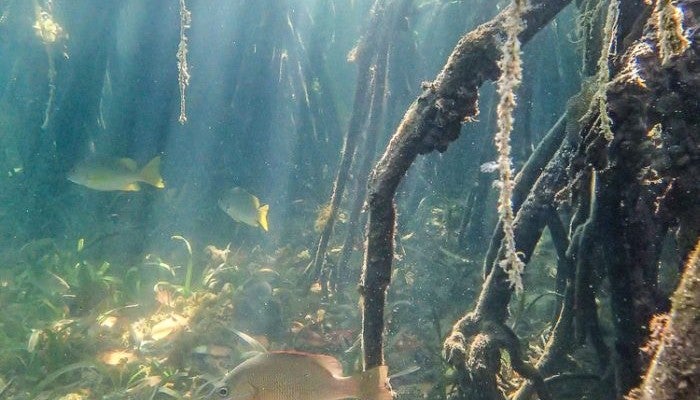By: Kendra Karr & Owen Liu
With support from the Waitt Foundation, EDF launched an initiative last year with the University of Havana’s Center for Marine Research that allowed teams of Cuban, U.S. and Mexican scientists to carry out a series of expeditions to conduct vital new research on Cuba’s remarkable—but understudied—marine and coastal ecosystems.
A Special Caribbean Reef
Coral reefs are some of the world’s most imperiled marine habitats. Impacts from climate change, pollution, overfishing and resource extraction combine to threaten reefs all over the world. This is especially true in the Caribbean, where rapid development is underway across the Caribbean Sea, exacerbating the stressors on coral reefs and their related seagrass and mangrove ecosystems.
However, in one special corner of the Caribbean, the Gardens of the Queen archipelago, has remained remarkably resilient in the face of this collective pressure. A Caribbean marine paradise, The Gardens consist of more than 600 cays and islands and is home to the largest contiguous reserve in the Caribbean at 2,170 square kilometers. It supports a mosaic of mangrove, seagrass, patch reefs, fringing red and reef slope and is abundant with fish, sharks and other marine life.
To reach the Gardens of the Queen from mainland Cuba, one must bisect the Gulf of Ana Maria, a shallow-water system comprised of mangrove, seagrass and coral reefs. The ecosystems of the Gulf of Ana Maria and Gardens of the Queen together cover more than 10,000 square kilometers of productive habitat, making the entire archipelago a magnet for eco-tourism, including SCUBA diving and recreational fishing. Despite a growing eco-tourism industry and offering one of the best examples of a resilient Caribbean reef, much about the Gardens remains a mystery.
We are excited about our partnership with the University of Havana’s Centro de Investigaciones Marinas (CIM) and the Centro de Investigaciones de Ecosistemas Costeras (CIEC), and the potential for collaborative scientific exploration to yield foundational data and information about marine habitats in and around the Gardens of the Queen. Our inaugural expedition in (February) 2013 harnessed expertise from a tri-national team of scientists, which shared knowledge and scientific methods while surveying migratory shark populations off Cuba’s south coast in the Gulf of Batabanó, to the west of the Gardens of the Queen. In October 2013, scientists from the three organizations hopped aboard the RV Felipe Poey and RV Itajara to journey to the Gardens reserve itself, and the nearby Gulf of Ana Maria. This 19-day expedition produced new data about the special Gardens ecosystems, and shared expertise among scientists from the three organizations, promoted collaboration, increased scientific capacity and forged new friendships.
Partners Gather
On October 12, 2013, scientists converged on the tiny town of Júcaro, Cuba, to embark on a 19 day research cruise. The American and Cubans scientists brought myriad tools, instruments and gear to assist in their collaborative research. As a result, a pier normally filled with ecotourism operators, tuna rods and shrimping nets was loaded down by SCUBA tanks, underwater cameras, GPS units, and notebooks and measurement devices of all shapes and sizes. Dr. Fabián Pina Amargós directed traffic on the dock, making sure each instrument was properly positioned, while making last minute course corrections. Fabián, a research scientist at CIEC with an energetic presence and loads of local experience and knowledge, proved indispensable to the expedition. Along with Dr. Jorge Angulo of CIM in Havana and EDF’s own Cuba Program Director Dan Whittle, Fabián formulated the objectives and plan in a manner to maximize the limited time of and resources for the expedition.
Meanwhile, other scientists from EDF, CIM, and CIEC checked and double-checked their equipment up and down the dock. It was a diverse group, composed of experts in coral reef and fish biology, as well ecology, marine chemistry, genetics and fisheries science and management. Each scientist brought his or her own expertise, experience and methods, providing the multi-faceted know-how necessary for robust interdisciplinary collaboration and cross-pollination.
The University of Havana and CIM deployed the Felipe Poey for the expedition. A converted fishing boat, it was named in honor of one of Cuba’s premier and pioneering marine scientists. A solid, functional vessel, the Felipe Poey became our home for the expedition. Her captain, Mariel Echevarria, has spent his life on the ocean, as a former distant-water fisherman in Cuba’s fleet. He and his crew, first mate Desiderio Hernandez and cook Aramis Vega, created an atmosphere of partnership, bonding, and collaboration that was infectious among the expedition members and set a collegial tone for the journey. Mariel, who didn’t speak a word of English, nevertheless was able to crack multilingual jokes and warm up the cabin or the deck. At the same time, he was extremely professional, keeping an old boat running smoothly and always getting us to where we needed to go. The entire expedition depended upon his knowledge and competence as a captain, but had fun thanks to his attitude and energy.
The RV Itajara, named after the iconic goliath grouper Epinephelus itajara, is a smaller boat, a research vessel from CIEC that we used to access shallow reef areas and small inlets that the larger Felipe Poey could not. Her crew, Captain Millo, first mate and mechanic Tito, and deckhand and research assistant Roy, was similar in attitude and aptitude to the Felipe Poey’s. From one minute to the next Tito and Millo could go from expertly steering the boat or fixing a mechanical malfunction, to setting up dive gear, and even hopping in the water themselves to assist in the scientific process. Overall, the crews of the research vessels on the expedition were essential to its success, and they symbolized the pervasive atmosphere of the voyage: hardworking and productive; but friendly, easygoing, and fun at the same time.
Investigating a Resilient Reef
Fabián, Jorge, and EDF’s scientists envisioned the October expedition as an opportunity to begin collecting important baseline biological and ecological data to support measures to better conserve and sustainable manage Cuba’s marine resources. Overfishing has eliminated many large and vulnerable fish species – groupers, for example – from broad areas of the Caribbean. In Cuba, scientists estimate that more than 40% of commercially valuable fish species are overfished, posing a major threat to Cuba’s fishing industry, food security and marine biodiversity. Cuba’s coastal waters are home to spawning grounds for snapper, grouper and other reef fish that are crucial to commercial and recreational fisheries in other regions of the Caribbean.
The Gardens of the Queen, an ecosystem not yet heavily impacted by human activity and resources extraction, provides scientists a unique laboratory to document the characteristics of a healthy Caribbean reef system. They can investigate questions like, how has this coral reef been resilient to the changes and degradation that we have seen in so many other parts of the Caribbean?
Answers to that question require a detailed understanding of how the different habitats of the Gulf and Gardens are interconnected. Therefore, one of the principal objectives of this cruise was to survey the Gulf of Ana Maria region and collect samples to assess connectivity between the nearshore habitats of the Gulf of Ana Maria and the Gardens of the Queen. Habitat connectivity is traditionally described as the connection and movement of species and nutrients between habitats. For example, some juvenile fish may utilize a nursery habitat like a seagrass meadow until they mature enough to transition into an adult habitat on the open coral reef. Inorganic matter can also display attributes of habitat connectivity: decomposed organic matter from mangroves, for instance, often adheres to coral reefs where it provides an important source of nutrients for the reef ecosystem.
Fish and other species depend upon the services and resources this connected set of marine ecosystems provides. Therefore, understanding how individuals, species and nutrients are distributed, and how they move between the Gardens of the Queen, the Gulf of Ana Maria and nearshore coastal waters of Cuba is a key step towards improving management of fisheries and marine biodiversity in Cuba. Oceanic currents spread larvae, fish and other material from the Gardens of the Queen to other regions of the Caribbean, meaning that management decisions in Cuba have implications for the wider ecosystem of the Gulf of Mexico and Caribbean Sea. Achieving truly sustainable Cuban fisheries requires that management officials recognize this interconnectivity and the underlying support ecosystem for those fisheries.
The Expedition Departs
Once all the SCUBA tanks had been strapped down, all the scientific gear stowed, and all crew aboard, Mariel’s Felipe Poey and Millo’s Itajara departed Júcaro on October 12, heading for the Gardens of the Queen, 50 miles and several hours away. During the course of the next 18 days, the expedition visited more than 30 sites across the expanse of the Gulf of Ana Maria and the Gardens of the Queen, assessing coral reef health, water quality, habitat structure and function, and fish community characteristics. This initial data collection and monitoring provides an essential baseline of knowledge about the ecosystem and fisheries health in the Gardens of the Queen – one we look forward to adding to on a consistent basis.










